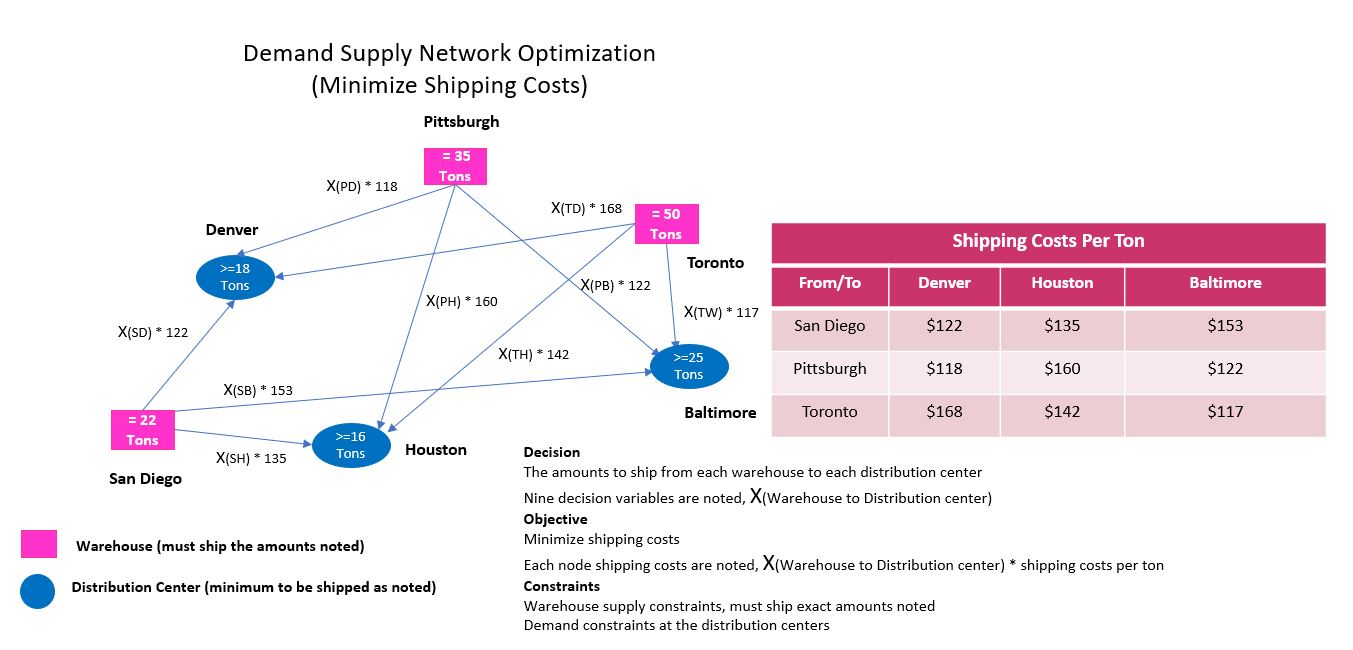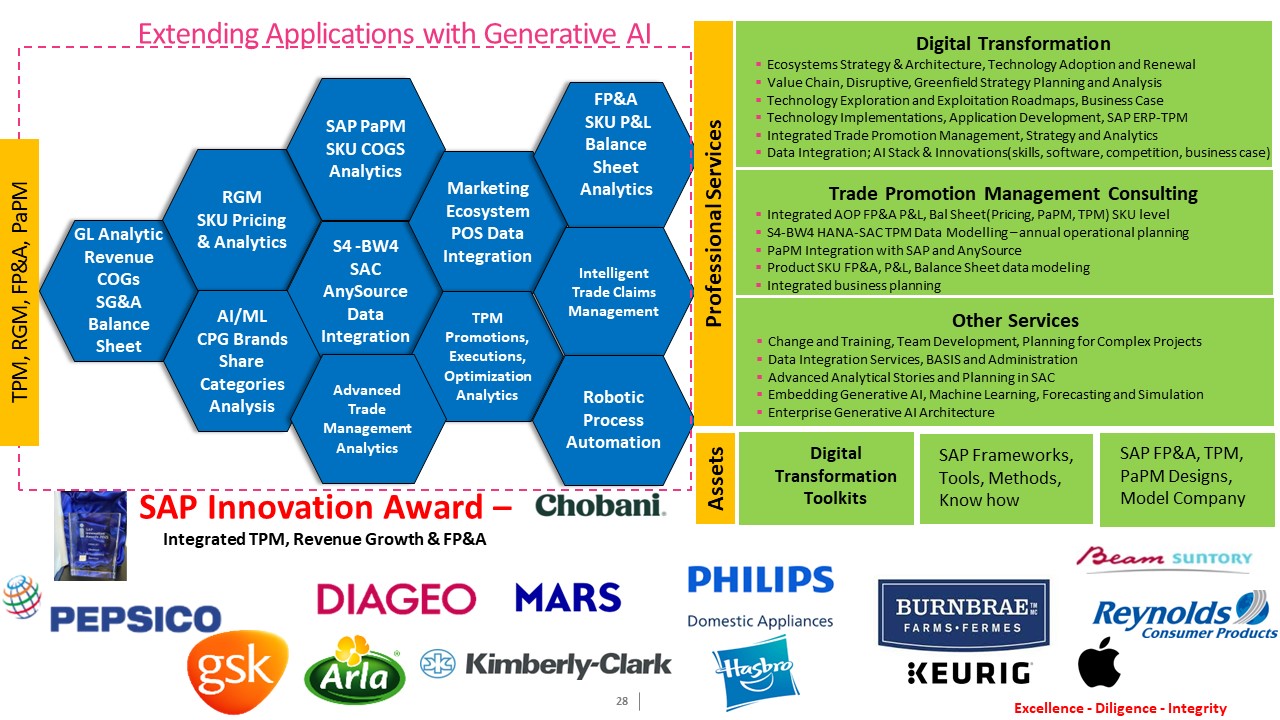


Industry disruption arrives with both a cost and risk. CTOs must balance the cost and risk to determine where in the innovation S-Curve they want to adapt to the disruptive technology. Enter early and the potential rewards could be massive. However, entering too early when the disruptive technology is not mature enough could result in a significant loss of core assets.
New business models, simplified business processes with smart predictive and optimizing analytics are key properties of a business transformation journey. Knowledge of today's capabilities helps create an end state target for your business landscape where you can plan, budget and manage projects to competitive change drivers. You need to adopt a basic strategy for analytics including a dependencies roadmap. Analysis of customer purchase data, competitor data, market data, social data and SKU data mined from corporate ERP transaction systems are required for modernized Financial Planning and Analysis, Commercial Finance and Supply Chain Finance Analytics used for growing or scaling the business ecosystem.
TekMetrix leadership, presence and decision making has the most impact when there are transformational changes in the business environment. When change occurs we lead. Our leadership capabilities that make a difference are:
Staffing our teams is purposeful, we maintain these attributes for our professional services teams:
Our methods and solutions enable the design and implementation of new end state corporate performance capabilities. Rapid accelerators derived from client experience and internal research are used to implement a multitude of modern business competencies based on simplified analytical data models, machine learning and clustering, AI, simulation and optimizing algorithms on your financial, logistics and human capital processes. All in memory and in real time with data lake extensions.
We separate the science of creating your strategy and technical road map from the mechanics required to implement. Our recommendations are supported by a detailed financial business case based on Capital, Net Cash Flow and Net Present Value with quantified Capital and Expense investment value against business process cost drivers. A full CFO view of Total Cost of Ownership (TCO).
We understand the process of technology disruption, and therefore we assist our clients recognize opportunities. Disruption can occur against the incumbents business model or technology in use or both. During the era of disruption many different business models and technologies are used by the industry to satisfy customer needs. Over time a dominant design for an ecosystem of business models and technologies is established. These are satisfying customer needs. After the dominant design is established an era of incremental innovation is established. Innovation will reach the limits of the business model and technology and the industry will mature, over time new business models and technologies emerge and the process repeats itself.
Industry change may happen within the core assets of the organization, within the business model itself or both the assets and business model.
A Model of Industry Distruption and Establishing a Dominant Design

| Disruptive Change for an Established and Mature Organization | |
| Business Model - Choices regarding | Core Assets - Resources and Capabilities |
| - Cost of Production and Profit | - SAP, Compute Platforms & Software |
| - Monetization | - Molecular, Product Research and Marketing |
| - Value Proposition | - Supply Chain Execution |
| - Customers | - Enterpise AI, ML |
| Change Management |
|
| Business Model Change | Change in Assets |
| - Harder than Asset Changes | - Challenging |
| - Complex | - Function of Investment |
| - Change Organization Incentives / Processes | - Can be Performed Internally through R&D |
| - Significant Uncertainty of Long Term Growth | - Strategic Acquisitions |
Create a user name and password to Log in. Once logged-in you will be able to download our tools and methodologies and share your experiences and feedback.
TekMetrix AnalyticAI uses trusted Buy Till You Die (BTYD) models. These models are a class of statistical models designed to capture the behavioral characteristics of non-contractual customers, where the corporate entity cannot directly observe when a customer stops being a customer. The goal of BTYD models is to forecast customer lifetime value by jointly modeling two processes:
Common versions of BTYD models include the Pareto/NBD model and the Beta-Geometric/NBD model. These models help businesses understand customer purchasing behavior and predict future purchasing patterns. Below is a TekMetrix AnalyticAI case history for developling an Industry CPG BYDT model and subsequent customer lifetime value.
There are modeling approaches for predicting outcomes under low uncertainty settings and a different modeling approach for predicting outcomes under high uncertainty. Linear programming, under low uncertainty settings, allows us to calculate an objective function and determine if the solution is feasible based on resource constraints. For high uncertainty settings we need to calculate the distribution for the key performance indicators and compare the distributions of outcomes.
Steps to calculate the distribution of the sales performance KPI for a product under high levels of uncertainty:
Roadmap for making decisions in high uncertainty environments:

A digital twin is a virtual representation of a physical object or system that is updated in real-time using data from sensors and other sources. It uses simulation, machine learning, and reasoning to help decision making. Digital twins are used to simulate the behavior of physical objects, systems, or processes to better understand how they work in real life. They can be used to study performance issues, generate possible improvements, and create valuable insights, which can then be applied back to the original physical object. There are various types of digital twins depending on the level of product magnification, such as component twins, parts twins, asset twins, and system or unit twins. Digital twins are used in various industries and applications, such as manufacturing, healthcare, and transportation.
SAP HANA is an in-memory database and application development platform that provides real-time data processing and analytics capabilities. R is a popular open-source programming language for statistical computing and graphics. SAP HANA provides integration with R through the RLANG procedure, which allows embedding R code in SAP HANA SQL code and execute it using the external R environment. We use R to perform statistical analysis, data mining, and machine learning on data stored in SAP HANA.
Additionally, R is software tool used to simulate manufacturing processes, that is to create a Digital Twin. We use a simulation package in R for discrete-event simulation that allows us to create statistical variables required for simulation, define process trajectory, define and assign resources, define arrivals, run simulation in R, store results in data frames, plot charts, and interpret the results.
To simulate a manufacturing process, working with your organization, TekMetrix will create process maps, gather data, build and test the simulation mathematical models, and work with your organization to analyze and interpret the results.
Delivery Methods
Prescriptive analytics seeks to analyze, for example, past consumer behavior to predict future behavior. Prescriptions are recommendations. Therefore, how do we define a prescriptive problem, how to set goals and objectives, how can the company optimize the goals and objectives, what actions can a company take to affect the outcome of their goals and how do companies respond to other companies actions?
The market structure needs to be a part of the model. If the company takes an action, for example, price change of the product, then how do other companies in the market respond? These are the questions that prescriptive analytics will answer. Willingness to pay (WTP) measures the maximum amount a customer is willing to pay for an incremental purchase of a product or service. WTP is calculated as:
WTP = ((New Price + Old Price) * Price Increment)/2 = > Trapezoidal Rule
TekMetrix WTP solutions improve brand performance by:
Powerful optimization technology is available to find the best solutions to complex problems faced by many organizations. Minimizing or maximizing an objective function which is dependent on variables such as costs, quantities, sales, price, profit while constrained by capacity, resources, dollars has been a well defined and utilized approach since the middle 1940s when logistics optimization mathematics were developed, known as linear and non-linear programming (LP) and integer (IP) programming. LP and IP models combined with AI algorithms will learn your business data and continuously maximize or minimize the objective function. We generally apply these optimization models to specific business challenges with low uncertainity to determine the most favorable outsome to the business problem.
Optimizing modeling with AI enables businesses to make data driven decisions, adopt new technologies, innovate and adopt to changing environments. With todays computational innovations and SAP transaction and master data modeled in HANA, SAC, PaPM significant upside potential exists for businesses to capture. An optimization model can have only one objective but can have many decision variable and constraints. For example if a company wants to optimize multipe key performance indicators such as profit, costs and resource allocation then we can choose one of the key performance indicators, like profit and treat the others as constraints.
Linear models are easier to optimize than non-linear models. Linear models involve constant parameters, multiplication products of decision variables and constant parameters and addition and subtraction. Non-linear models involve products of decision variables, ratios of decision variables, power or roots of decision variables, anything beyond a linear function.
Simplified solver model optimizing demand supply objective with decision variables and constraints

Predictive analytics involves various algorithms and techniques to forecast future outcomes based on historical data. They are the backbone of operations research professionals, and now with AI are available to larger parts of an organization. These algorithms have been available for 50+ years yet not often are not deployed by a corporation. If used, most often they deployed in Excel, which is limited in the amount of data that can be ingested.
These algorithms need be deployed on large data sets, Hana, S4/HANA, BW, and Hadoop with BTP integration from multiple sources to be fully effective. With modern compute power and infrastructure, and with the integration of these algorithms to an AI tool, they can be effectively deployed.TekMetrix analyticA architectue uses AI LLM models optimized for software development to deploy these algorithms for highly value add process scenarios. Here are some of the key algorithms and techniques used.
What is a Sales Forecast Example?
Data in the CPG industry comes from a variety of sources including SAP sales and supply chain transaction data, marketing sources and customer behavior. The CPG industry is challenged with creating analytics on this data and using the data for predictive and optimizing purposes. The complexity lies in creating a data model. Without a proper knowledge of HANA columnar databases, open source databases and POS integration technology forecasting and analyzing SKU data is a challenge. Predictions that need be made are which customer is going to buy what product next, how many purchases are they going to make and what is the customer churn? What is my customer life time value, how often to they buy and when was the last time they bought a product. Other types of predictions include trade and promotions, pricing, conversion costs and marketing (sg&a) costs. TekMetrix tools are readily available for making these predictions and more. SKU level predictions can be made and structured into a P&L (SKU) level, cash flow and balance sheet. Analysis of the P&L and other financial documents can be done by SKU, customer, geography, brand and other attributes, including aggregations. We can forecast into the future your customer lifetime value (CLV).
The question becomes, how to design and develop an underlying data model supporting a variety of analytics and predictive metrics including embedding AI and ML capabilities into the underlying data model? TekMetrix data AI ML models and experience will accelerate your project timelines and add significant value to your business.
If you want to run your business most effectively, we need to make predictions about the future. Predictive analyical forecasting takes historical data and creates a one or multi period forecast. TekMetrix data analysis helps examine past performance and also helps to predict future performance, for example predicting questions like:
We want to make "when will" predictions for a fixed period and multiple periods in the future.
Predictive statistics uses statistics for prediction and forecasting generally one period ahead of the current period. The mean of the prediction is the sample mean which is an unbiased estimation of the mean of true demand distribution. Standard deviation for prediction needs to be adjusted if there is insufficient data. If the data is normally distributed than the data can be adjusted for predictive purposes.
If there is a trend in the data, than moving averages, mean and standard deviation computations used for predictive purposes will lag the trend. Therefore, linear regression or exponential smoothing are additional forecast options.
The regression equation and its variants are used in Artificial Intelligence (AI) and Machine Learning (ML) modeling. These equations help us understand the relationship between independent variables (features) and a dependent variable (target) by fitting a mathematical function to the data. Various types of regression models, such as linear regression, polynomial regression, and logistic regression, are commonly employed for prediction, classification, and modeling tasks. These models can be developed in SAP HANA, SAC, PaPM. Additional tools could be MatLab, R, Python, or for smaller models in Excel.
AI integration with Corporate Data and Linear Regression:
By managing these steps, TekMetrix AI integration can streamline the entire process of creating and continuously updating a sales forecast. Let’s say we have billions of records in S4-BW4/HANA. We input the data along with variables like marketing spend, holiday seasons, supply chain cycle times, availabilities and econometrics. TekMetrix AI preprocesses the data, selects the best predictors, trains the forecast model, evaluates model performance and then uses it to forecast next month’s sales.
